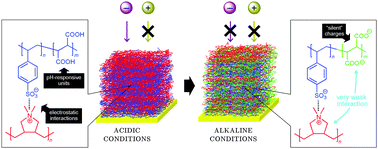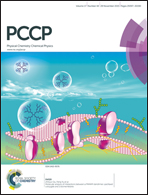pH-responsive ion transport in polyelectrolyte multilayers of poly(diallyldimethylammonium chloride) (PDADMAC) and poly(4-styrenesulfonic acid-co-maleic acid) (PSS-MA) bearing strong- and weak anionic groups†
Abstract
The layer-by-layer construction of interfacial architectures displaying stimuli-responsive control of mass transport is attracting increasing interest in materials science. In this work, we describe the creation of interfacial architectures displaying pH-dependent ionic transport properties which until now have not been observed in polyelectrolyte multilayers. We describe a novel approach to create pH-controlled ion-rectifying systems employing polyelectrolyte multilayers assembled from a copolymer containing both weakly and strongly charged pendant groups, poly(4-styrenesulfonic acid-co-maleic acid) (PSS-MA), alternately deposited with poly(diallyldimethylammonium chloride) (PDADMAC). The conceptual framework is based on the very contrasting and differential interactions of PSS and MA units with PDADMAC. In our setting, sulfonate groups play a structural role by conferring stability to the multilayer due to the strong electrostatic interactions with the polycations, while the weakly interacting MA groups remain “silent” within the film and then act as on-demand pH-responsive units. When these multilayers are combined with a strong cationic capping layer that repels the passage of cationic probes, a pH-gateable rectified transport of anions is observed. Concomitantly, we also observed that these functional properties are significantly affected when multilayers are subjected to extensive pH cycling as a consequence of irreversible morphological changes taking place in the film. We envision that the synergy derived from combining weak and strong interactions within the same multilayer will play a key role in the construction of new interfacial architectures displaying tailorable ion transport properties.


 Please wait while we load your content...
Please wait while we load your content...